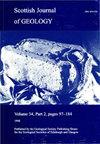爱尔兰和苏格兰南部高地的碳质残留物
IF 1.3
4区 地球科学
Q4 GEOLOGY
引用次数: 1
摘要
碳质残留物存在于爱尔兰和苏格兰(南高地朗福德-唐恩)下古生代增生三棱镜的泥岩和浊积岩中。在下古生代和石炭-三叠纪时期,吸积棱柱是流体运移的主体,因此碳质流体的年龄是不确定的。下古生代岩石中碳质残留物的拉曼光谱数据表明,其古温度与其宿主岩相似,远高于石炭系盖层或盖层中残留物的古温度。这些数据表明棱柱岩中的残留物是下古生代的,而不是由更年轻的矿化流体贡献的。这些残留物代表了棱柱中的烃源岩产生的碳氢化合物,这些烃源岩是Iapetus洋奥陶系-志留系沉积物的一部分。本文章由计算机程序翻译,如有差异,请以英文原文为准。
Carbonaceous residues in the Southern Uplands accretionary prism of Ireland and Scotland
Carbonaceous residues occur in mudstones and turbidites of the Lower Paleozoic accretionary prism in Ireland and Scotland (Longford-Down, Southern Uplands). The accretionary prism was host to fluid migration during both the Lower Paleozoic and Carboniferous–Triassic, so the age of the carbonaceous fluids is uncertain. Raman spectroscopy data for the carbonaceous residues in the Lower Paleozoic rocks indicate palaeotemperatures similar to those measured in their host rocks, and much higher than those in the Carboniferous cover rocks or in residues in the cover rocks. These data show that residues in the prism rocks are of Lower Paleozoic age, and were not contributed by younger mineralizing fluids. The residues represent hydrocarbons generated from source rocks in the prism that were part of the Ordovician–Silurian deposits of the Iapetus Ocean.
求助全文
通过发布文献求助,成功后即可免费获取论文全文。
去求助
来源期刊

Scottish Journal of Geology
地学-地质学
CiteScore
1.70
自引率
0.00%
发文量
10
审稿时长
>12 weeks
期刊介绍:
Although published only since 1965, the Scottish Journal of Geology has a long pedigree. It is the joint publication of the Geological Society of Glasgow and the Edinburgh Geological Society, which prior to 1965 published separate Transactions: from 1860 in the case of Glasgow and 1863 for Edinburgh.
Traditionally, the Journal has acted as the focus for papers on all aspects of Scottish geology and its contiguous areas, including the surrounding seas. The publication policy has always been outward looking, with the Editors encouraging review papers and papers on broader aspects of the Earth sciences that cannot be discussed solely in terms of Scottish geology.
The diverse geology of Scotland continues to provide an important natural laboratory for the study of earth sciences; many seminal studies in geology have been carried out on Scottish rocks, and over the years the results of much of this work had been published in the Journal and its predecessors.
The Journal fully deserves its high reputation worldwide and intends to maintain its status in the front rank of publications in the Earth sciences.
 求助内容:
求助内容: 应助结果提醒方式:
应助结果提醒方式:


